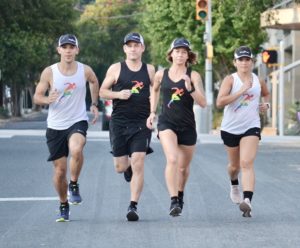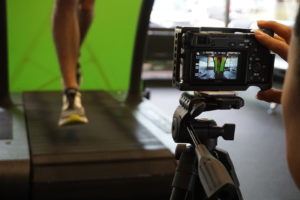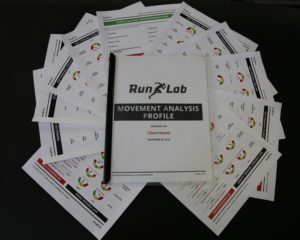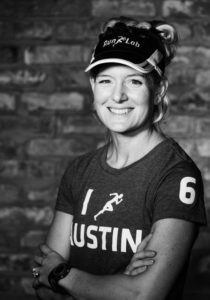 THE MYTH: There is a “right” way and a “wrong” way to run.
THE MYTH: There is a “right” way and a “wrong” way to run.
THE REALITY: There are a LOT of right and wrong ways to run, it depends on your structure, range-of-motion, strengths, limiters, injury history, and goals.
Seem like a lot to consider?!?!
It is! Read on…
There are more runners hitting the trails than ever and that, unfortunately, means more injuries. Some studies estimate that upwards of 90% of runners will end up injured in any given year. Given the fact that millions upon millions of dollars have been spent on shoe design over the last 50 years, why are injury rates still the same, or even higher, than they ever were?
The answer?
It’s not about the shoe. Consider the following recent case study from our clinic: A new mom, we’ll call her Kristie, takes up running as a way to add exercise into her life. She is excited about running because it’s convenient, she can run with her baby in a jogger, and it’ll help her lose that added baby weight. She even thinks she might like to train for a half marathon or a triathlon at some point so she joins a social run group geared towards moms. She goes to her local running store, gets fit for shoes, is told she’s a “pronator” and is put in shoes meant to control that extra movement in the foot. She starts running 3xs per week on a run/walk program and reaches 15 mile/week before she begins to have pain in her knees. She doesn’t think she is “injured” per se, but figures she should get it checked out anyway and makes a visit to her general practitioner. Her doctor recommends she take a break from running until the pain is gone. She is frustrated but takes two weeks off anyway.
She begins running again and within two weeks has that same pain start up. She revisits her local store, where they recommend inserts and perhaps a different shoe. She tries the inserts first and sees very little changes so she returns to the shoe wall two weeks later. They help her pick something a bit more neutral, with the advice that she also use the inserts due to that pesky overpronation problem. She is excited to get back on track and starts running again with her social group, but the following week, guess what? Same knee issues. One of her running friends tells her that she read people need to run with a 180 cadence and that she should be landing on her midfoot. Kristie has no idea what that means so she does some research and starts trying to run this way. She feels like she is running in a fairly unnatural way and also quite out of breath, but the knee feels a little better!
Progress?! But…wait for it, the knee pain returns two weeks in and NOW she also has calf pain. She returns to her running store, gets put in another pair of shoes and decides in frustration to just run through it if the pain returns, which it does immediately. She keeps running until things hurt enough that she decides that maybe running isn’t for her. She is now hundreds of dollars and several months into running and is worse off than when she started.

She does a bunch more research online and finds RunLab™. In a last ditch effort to see if we can help, she calls us. She lives in Dallas so we send her over to one of Gait Imaging Center™ locations inside of Playtri. She sets up her account online, pays, fills out her forms so our team understands her history and goals, and then sets up a time to get filmed on-site at the Gait Imaging Center™. The Playtri staff takes care of her entire filming process and guides her through from start to finish. The patent-pending process includes both running and full-body movement pattern analysis through advanced video-capture technology, along with a full-body structural, range-of-motion, and strength assessment.

Once all of Kristie’s videos have been uploaded, our team analyzes her data and provides her a full color 14-page report which breaks down everything she needs to know about the way she moves, where her strengths and limiters are, and a Footwear Prescription™.
What does she learn about her running and knee pain? She learns that onset of her pain stemmed from a structural finding (slight knock knees) combined with extreme hip weakness due to recently giving birth. She was highly unstable during the loading phase of gait and it was putting undue stress on her knees. The onset of her pain didn’t have anything to do with the shoe she was in. In fact, the shoes meant to control motion were actually making the issue worse because they were not allowing her foot to move through the normal pronation cycle, which moved stress up into her knees. The second and third pair of shoes were not increasing load, but they also weren’t solving the underlying issue. With some gait re-training exercises and strength work specific to her structural and functional limiters, Kristie got back on track, has been running consistently for a full year and just completed her first half marathon with her daughter in a baby jogger.
The right shoes will aid your body’s ability to move naturally and as efficiently as it can in its current state, but no amount of shoe technology can solve for a weakness in the body. There is a lot of misinformation out there about running form. People are constantly coming into RunLab™ to tell us about their struggles to “fix” their heel strike, to run with higher cadence, to get their “glutes to fire”, to “stop overpronating”, etc., etc. But the problem lies in the fact that these runners have very little understanding of how THEIR body is built. There are thousands of variables that go into a person’s ideal movement pattern. Changing the way you move isn’t necessarily taking away the load, it just means you are moving it around to another area which can be more, or sometimes less, equipped to handle that load. This is where a Movement Analysis & Gait Evaluation comes into play. It is important not only to understand the way you are built, your current range-of-motion, strengths and limiters but also the way your body has adapted to move through them. Our brains are amazing at creating workarounds for even the slightest weakness, and when we layer compensation pattern over compensation pattern (even as non-runners) for years, there is a lot that goes into unraveling the ball of biomechanical yarn strand by strand. Creating increased range-of-motion in one area, for instance, can create stability problems, causing another area to develop compensatory hypertonicity.
So, what is the take-home message?
If you don’t understand your unique structure, range-of-motion, strength and limiters, it is very easy to get pulled down the rabbit hole by the mountain of information from articles, under qualified coaches, wearable technology, and your running friends who “read somewhere that you should run with your feet facing forward”. Understanding your body should be the springboard to any good training plan. And remember, shoes matter, but there isn’t a shoe in the world that can replace working on your biomechanics.
IN SUMMARY:
- Full-body multi-plane Movement Analysis & Gait Evaluation is key to understanding your body, how it moves, and where the load is.
- Shoes should let your body move the way it needs to, not stop natural movement.
- Pronation is not a “bad” thing, your foot needs to pronate for your body to absorb shock actively. Your structure, range-of-motion, strengths, goals, and limiters are not the same as the next person’s.
- The “right” or “wrong” way to run is unique to you and you alone.
ABOUT DR. DAVIS

Dr. Kimberly Davis is the Founder & CEO of RunLab™, a motion analysis and gait diagnostic company headquartered in Austin, Texas that provides runners anywhere in the country access to comprehensive gait evaluation services through www.RunLab.us. An Ironman triathlete and ultra-distance adventure racer herself for over 20 years, Dr. Davis has dedicated her career to the study of clinical biomechanics and helping runners get back on the trails, improve their performance and enjoy running again. Working as part of sports medicine teams for over a decade, she grew tired of hearing her patients say they had been told not to run or that “running is bad for your knees” by their doctors without any discussion about biomechanics. She launched RunLab™ Austin in 2014 as a running-centric healthcare facility built entirely by, and for, runners. It has since grown to become one of the nation’s preeminent gait evaluation and training facilities in the U.S. Working with every age and experience level runner, from Olympic gold medalists and world champions to brand new runners, kids, and runners with special needs such as down syndrome, cerebral palsy, and a wide variety of movement disorders. Recognizing a lack of consistency and quality in gait analysis across the country, Dr. Davis launched RunLab.us in 2018 as a means for runners to access her industry-leading gait team from anywhere in the United States.
Thank you for taking the time to read our RunLab™ Blog! We hope that you use this information to run more injury free and to optimize your running performance.
For more information about the RunLab™ team and to get your running stride analyzed by one of the preeminent gait specialist teams in the country, please visit WWW.RUNLABAUSTIN.COM
Outside of the Austin area? You can still have your running stride analyzed by one of the best teams in the country. Just visit WWW.RUNLAB.US to see where our partner filming locations are based or choose the self-film option.
RunLab™. Helping runners help themselves.
![]()
LEARN MORE:
RunLab™ Podcast RUN.
RunLab™ YouTube channel
